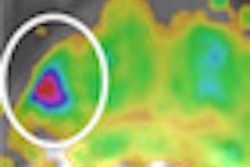
Researchers from the Netherlands have found that an evaluation of a robotic technique to use for transrectal MR-guided prostate biopsies of men suspected of having cancer fell short of expectations. They concluded the combination of a larger biopsy error and the extra technical effort and time to perform the robotic technique did not yet make it feasible for the new procedure to replace existing manual techniques.
These were disappointing findings for the multidisciplinary team from Radboud University Nijmegen Medical Centre in Nijmegen, which had developed a fully MR-compatible, pneumatically controlled manipulator with 5° of freedom to guide biopsies under real-time MRI. They presented their study in an article published online on 29 September in European Radiology.
 First-generation robotic device, showing blue tubes that deliver compressed air to the pneumatic motors. Image courtesy of Dr. Martijn Schouten.
First-generation robotic device, showing blue tubes that deliver compressed air to the pneumatic motors. Image courtesy of Dr. Martijn Schouten.MRI of the prostate is a useful modality to accurately detect and localize benign or malignant changes within the prostate gland, and leads to high tumor localization ability. However, lack of specificity in prostate MRI has required that biopsies of tissue samples be performed. The combination of MRI with biopsies produces high sensitivity and specificity. However, it is an unpleasant process for the patient and very time-consuming for the radiologist.
For this reason, Dr. Martijn Schouten of the department of radiology and colleagues developed a pneumatically actuated MR-compatible robot enabling needle-guide direction to be controlled in real-time inside the controller room. The robot uses a stepper motor that delivers highly accurate positioning with momentum and speed.
Between February and August 2010, the researchers enrolled 14 consecutive patients to be biopsied, either manually or with the robotic technique. Thirteen patients had an elevated prostate-specific antigen (PSA) level greater than 4 ng/mL. Prior to the procedure, they underwent a 3-tesla multiparametric MRI examination (Magnetom Trio, Siemens Healthcare) for the identification of suspicious regions of cancer. For each region, the volume was determined on the MR images, assuming that the lesions were ellipsoids.
Within 12 weeks after diagnosis, the patients underwent a robotic transrectal MRI-guided biopsy. After a needle guide filled with gadolinium-doped water was inserted in the rectum of the patient, it was mounted to either the manual or robotic device. The insertion depth of the needle was measured after achieving correct alignment of the needle guide, then the patient was slid out from the MRI gantry so that the biopsy needle could be manually inserted.
True fast imaging with steady-state free precession (true FISP) sagittal and transversal images were acquired to confirm correct positioning of the needle guide. Both total procedure time and manipulation time were recorded for both the robotic and manual techniques.
Findings
The researchers analyzed a total of 32 needle positions. The mean targeting error for both the robotic (5.7 mm) and manual (5.8 mm) were almost identical and not statistically significant. The mean biopsy error was greater with the robotic technique (6.5 mm) compared with the manual technique (4.4 mm), and target displacement was larger with the robotic technique (6.6 mm versus 6.0 mm).
The mean time to perform the biopsy procedure was 76 minutes compared with 61 minutes for the manual technique. Manipulation times to move from target to target were relatively comparable, at six minutes for the robotic technique compared with eight minutes for the manual technique. The longest amount of time spent for either procedure was 11 minutes.
The researchers determined that most target displacement was located in the direction of the needle trajectory. This suggested that most of it was caused by needle insertion. Image registration would not correct for prostate motion due to needle insertion, according to the authors.
Although the robotic technique prevented the need of moving the patient in and out of the MRI system bore for manipulation and imaging of the needle guide, positioning of the patient was still a precise, time-consuming process. It was necessary for some actions to be performed at the MRI console, requiring the operator of the robotic device to switch constantly between the MRI console and the monitor for the robot. Added to a statistically significant larger biopsy error, the manual technique remains the recommended one, according to the authors.


















